Music streaming apps have become an integral part of our everyday lives. They’re so common that every smartphone has at least one music streaming service installed by default.
But do you know what makes an application so convenient and featureful, well, it’s the technology behind it.
The collection of technologies that are used in music streaming applications, or any other app, is called its tech stack or solutions stack.
While it is important to have an easy-going UI and the latest collection of songs on your application, choosing the right tech stack is the fundamental block for a successful music streaming app.
For anyone planning to penetrate the music-streaming app market, it is crucial to focus on the technologies that will power the application.
If you too are wondering how to choose the right tech stack for a music-streaming app, this is the post for you! In this one, let us take a closer look at all the factors that you must consider when choosing the bundle of technologies for your application.
Overview of Tech Stack for Music Streaming Apps
A music streaming application tech stack usually consists of a programming language, databases, cloud platforms, and frameworks.
To give you a perspective on music streaming app trends and the apps that are developed, the following are the technologies that can be used to power a –
| Component | Technology |
| Cloud Platform | Amazon Web Services, Google Cloud Platform |
| Databases | MongoDB |
| Framework | React Native |
| Programming languages | Kotlin, Java (Android), Swift, Object C (iOS) |
| Content Distribution Network | Amazon CloudFront |
| Message Broker | RabbitMQ |
| Streaming Tech | Wowza |
| Payment Gateway | PayPal, Stripe, etc. |
It is these fundamental technologies that have allowed the music-streaming app market to rise and shine over the years.
So much so that the projected revenue for the music-streaming market is expected to touch US$35.45bn by the end of 2025 with a CAGR of 4.90% for 4 years i.e., 2025-2029.
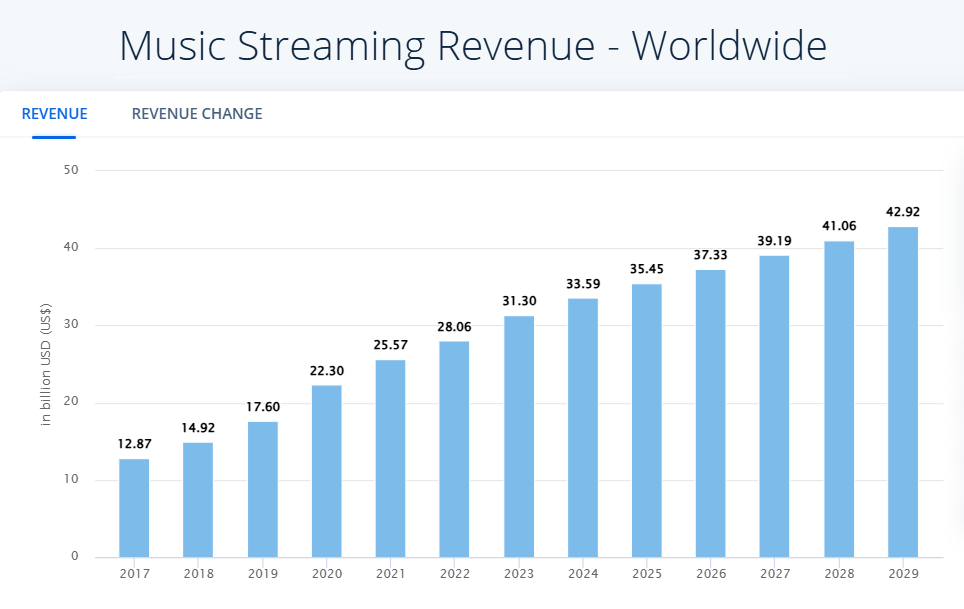
Other than these technologies, music streaming apps often go for third-party integrations for a smoother experience for their users.
For example, the top music streaming app in the market, Spotify uses Apache Kafka to smoothen big data processing, to build a recommendation engine, and for real-time music streaming.
The tech stack for a music streaming app can be quite typical to crack as you need a lot of clarity on what your core features are and what additional features you want to integrate.
However, a proper development service can be helpful in such a scenario, considering the developer has an idea of what works and what doesn’t.
Importance of Choosing the Right Tech Stack for Music Streaming App
The importance of choosing the right tech stack is surreal. Not because these technologies help you build the app, but because these technologies ensure that your application stays functional and can be scaled.
While the market offers lucrative opportunities to grow and earn, it is also one of the toughest markets to penetrate.
That is because there are already several players like Spotify, Apple Music, Amazon Music, YouTube Music, etc. that are dominating the music streaming market.
What makes these apps a preference of the users is the set of features that they offer. Features that are impossible to implement without a scalable tech stack.
Several factors make choosing the right tech stack for music streaming apps crucial. These factors include-
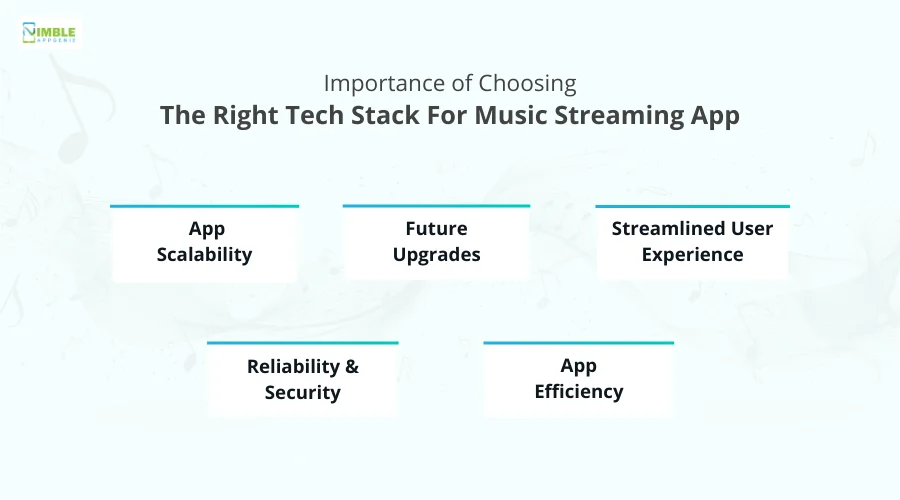
► App Scalability
The music streaming application that you build should be scalable as over time the number of users will increase.
The tech stack you choose defines the ability of your application to scale as required, without compromising on the performance.
► Future Upgrades
The tech stack you choose enables future upgrades. If you end up choosing a tech stack that has limited support or might go obsolete in the future, rolling out new features as required can be difficult. Hence choosing the right tech stack is crucial.
► Streamlined User Experience
Your choice of tech stack defines how your app appears to the user. The finer your selection of technologies, the more streamlined the experience for your user.
This can also help your application for better user retention.
► Reliability & Security
For any user to rely on your application, it has to use the best technology that makes it secure and reliable. No one wants an application that can’t keep the generated data secure and keeps crashing.
With the correct combination of tech, both your app’s reliability and security
► App Efficiency
The efficiency of your music streaming application also depends on your choice of tech stack. That is because several technologies often do not go together.
You have to be diligent in choosing the correct combination so that the outcome is efficient.
All these factors, directly or indirectly, depend on what type of tech stack you choose for the development process.
Hence, you should consider researching and spending enough time on deciding which technologies to use for your music streaming application.
What makes choosing the right tech stack for a music streaming app the most important aspect of the entire development process is its impact on the app’s performance.
How to Choose the Best Tech Stack for Your Music Streaming App
Knowing why it is important to choose the right tech stack for a music streaming app, you may be wondering how to begin the process.
Well, there are several things to consider while making the decision.
Factors such as your target audience, and available development experts do play a crucial role however, the considerations do not stop here.
To choose the best tech stack for your music streaming app, there are several things that you should consider. These factors include –
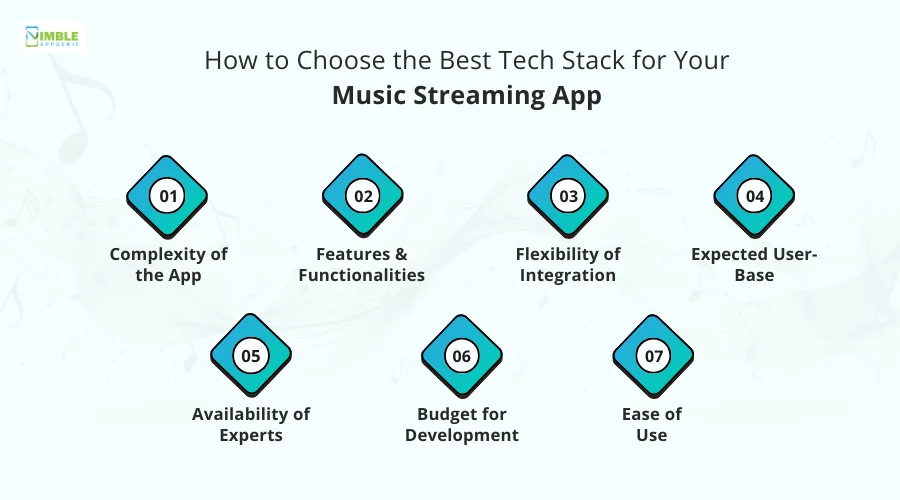
♦ Complexity of the App
Understand the objective of your music streaming app. This means you must identify the exact way your app will work.
It will help you learn more about the complexity of building an app, making it easier for you to choose the tech stack for music streaming apps
The more complex your application is, the more simplified tech you should try to use.
Choosing a certain programming language or framework can actually help you simplify the process by reducing the complexity of implementing a particular feature.
♦ Features & Functionalities
Before deciding on the tech stack for your music streaming application, you must finalize the functionalities and features that you want to implement.
This way, you can easily look for technologies that can help in developing those functionalities for your app.
For instance, if you want your application to offer a recommendation engine that understands the user’s preferences, you will need AI and Machine learning in your tech stack to implement them.
Similarly, analyzing the features you want in the app can help in finding the best tech stack.
♦ Flexibility of Integration
Before choosing any technology to start the development process of your application, you need to ensure that the bundle you use is compatible with different APIs that can be used to enhance the functionality of your application without having to build a feature from scratch.
Other than APIs, various custom components may require integration in your application in the future. Choosing a tech stack that is integration-flexible can future-proof your application.
♦ Expected User-Base
Consider your target audience and expected users of your application. If you are targeting a particular age group with your music streaming app, you have to choose a tech stack that helps you with the targeting properly.
Not to mention, you should keep in mind the average number of simultaneous users on your app.
Since it is a music streaming application, there is going to be a substantial amount of regular users and the app should be able to handle it.
♦ Availability of Experts
While there are a lot of technologies that can help you develop a music streaming app with the best tech stack, it is not always possible to choose them.
That is because opting for a technology is not the only thing you have to consider. You also have to find experts to implement the same.
If you choose a technology that only a few experts can help you with, getting extensive support in the development process can get quite difficult.
Before you choose the tech stack for music streaming apps, make sure you research the availability of technology experts.
♦ Budget for Development
While everyone suggests that you should have the best cutting-edge technologies implemented in the application, we highly recommend that you look for the best tech stack in your budget for a music streaming app.
It is understandable that every project has a set deadline and set budget and it is not always feasible to go for the highest technology available.
It is okay as long as all the objectives of your applications can be met with the available resources, as it can help you minimize the cost of music streaming app development to a decent extent.
♦ Ease of Use
The right tech stack for music streaming is the one that provides ease of use for both the developers and the users of the application.
You should choose a tech stack that allows you to easily upgrade the architecture of your application without any limits.
The tech stack of your music streaming application should be easy to manage and it should not be too complicated for any new developer who joins the maintenance team for your application.
Other than these factors, you should also consider the community support for the technologies that you opt for.
Choosing the correct bundle of tech for your music streaming application is quite a tedious task hence we recommend you consult the developers and take their inputs as they can advise you better, giving you insights and confidence on what you plan to build.
Custom Components of a Music Streaming App Tech Stack
The stack that you choose is implemented to create different components of a music streaming app. These components work in sync to create an experience for the users.
A music streaming app tech stack consists of 4 key components –
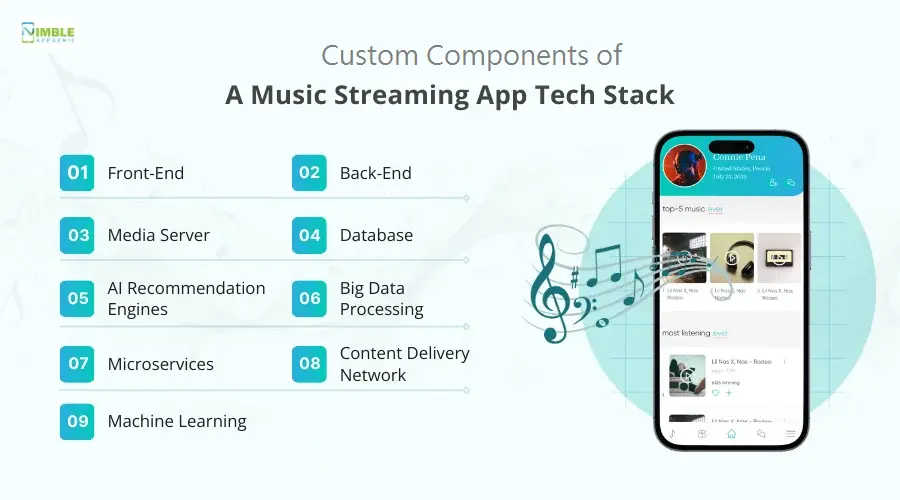
• Front-End
This is your music app design or the mobile app that a user interacts with. It provides basic and advanced functionalities to the users such as a music library, creating playlists, navigating through tracks, etc.
• Back-End
This is where all your processes take place. All the user requests are processed and are instantly visible on the front end.
The backend helps your application manage songs and playlists, and store user data as it comes.
• Media Server
Streaming music directly from the licensed library can only be done with a robust media server. Implementing a media server helps optimize the bitrate of the music simultaneously according to the user’s internet speed and device conditions.
• Database
In any music streaming application, there is a lot of metadata that you have to take care of.
From music information user data, the database you choose takes care of handling all of it for the application.
However, modern music streaming applications are not limited to these components as there are custom components that are integrated into the apps to make them better.
Some of these custom components include –
• AI Recommendation Engines
This added component allows your application to make the most out of user-generated information as these analyze the listening patterns of the user to provide track recommendations.
• Big Data Processing
When you have so many users simultaneously using the music streaming application, the volume of data generated requires big data processing so that it can be broken down to understand the analytics which can be used for further decision-making and maintenance.
• Microservices
These help in version control and easy transitions. Using microservices enhances the flexibility of the application as it offers great fault tolerance.
This means if a feature is made using microservices and it has an issue, it will not affect other music app features and can be easily fixed.
• Content Delivery Network
With the help of a CDN, you can simplify content delivery at high quality as the network of servers is spread across the world and allows the user to access the demanded content from the nearest server for an optimized experience.
• Machine Learning
This helps in curating user-oriented features and music recommendations along with additional features such as voice controls, and chatbots that can directly interact with the user.
With all these components working together, you can easily create an app like Spotify or any other for that matter. However, keep in mind that these are custom components.
Adding all of them or a few of them is completely at your discretion but will also affect the cost of development.
Popular Music Streaming Apps and Their Tech Stacks
Several music streaming services offer high-quality music streaming to its users. All of them have some basic technologies powering them. Popular music streaming apps usually prefer:
- Java or Kotlin for Android,
- Swift or Objective C for iOS,
- A cloud platform like AWS or GCP,
- A NoSQL database like MongoDB,
- Media streaming services,
- Frameworks like React Native
While it may not be possible to cover the tech stacks of all the popular apps in a single post, here is a list of technologies that Spotify the most in-demand streaming application of all time uses –
- Front-End: JavaScript, React, Redux
- Back-End: Java, Cassandra, Kafka, Docker, Kubernetes
- Programming Languages: Swift, Kotlin, Python, Java, C++
- Cloud Services: AWS, GCP.
What makes Spotify the ultimate music streaming platform is its ability to incorporate machine learning algorithms to create a personalized experience for the user.
It actually uses outstanding AI recommendations by adapting to the user’s preferences, keeping them engaged.
The success Spotify has seen is the perfect example of what can happen when you have a perfectly balanced tech stack.
You can start with a basic application as well; however, choosing the right tech stack for a music streaming app is the most crucial step.
Nimble AppGenie: Your Tech Stack Partner to Develop a Music Streaming App
Choosing the right tech stack for music streaming is one of the most common challenges in music app development that you may come across, especially if you are new to the field.
Even with a lot of research and analysis, you might make a mistake in choosing a technology. What you need is a tech stack partner to help you identify the necessary technologies.
This means if you can choose a compatible music streaming app development company to assist you with the process, you need not worry about choosing the tech stack at all.
If you are looking for help in choosing the right tech stack for a music streaming application, Nimble AppGenie can be your perfect companion.
With years of experience and expertise in the development field, our expert developers are always ready to guide you through. Reach out today and turn your idea into a fruitful reality!
Conclusion
Technologies are the building blocks of any music streaming application. Choosing the right solution stack is crucial as it defines the functionality and the future of the application.
While choosing the right tech stack for a music streaming app, you need to focus on several things such as if it is feasible in terms of expert availability as well as cost.
Not to mention, you should know the objective of your application as it helps in identifying the technologies that may be required to develop the app.
Hope all the information shared in the post helps you choose the right tech stack for a music streaming app. This is all for this post, thanks for reading, and good luck!
FAQs
One of the best examples of a tech stack used by popular music streaming apps is given below –
Tech Stack of Spotify –
1. Front-End: JavaScript, React, Redux
2. Back-End: Java, Cassandra, Kafka, Docker, Kubernetes
3. Programming Languages: Swift, Kotlin, Python, Java, C++
4. Cloud Services: AWS, GCP

Niketan Sharma is the CTO of Nimble AppGenie, a prominent website and mobile app development company in the USA that is delivering excellence with a commitment to boosting business growth & maximizing customer satisfaction. He is a highly motivated individual who helps SMEs and startups grow in this dynamic market with the latest technology and innovation.
Table of Contents




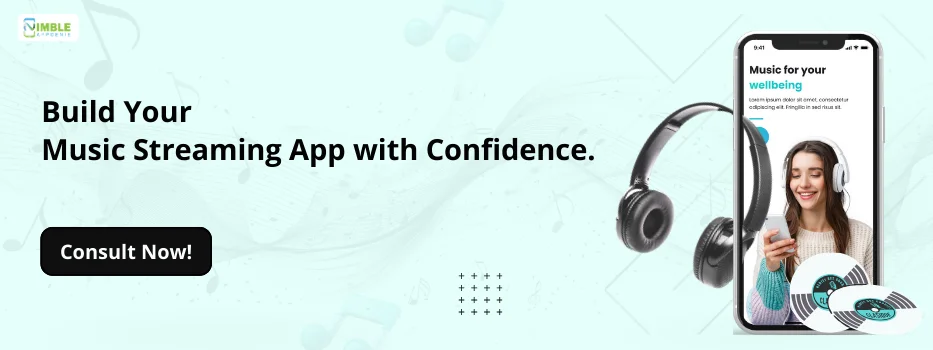
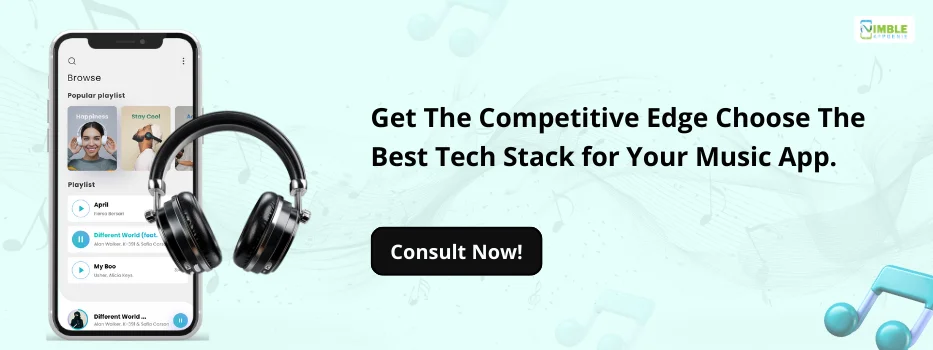
No Comments
Comments are closed.